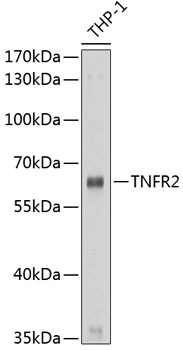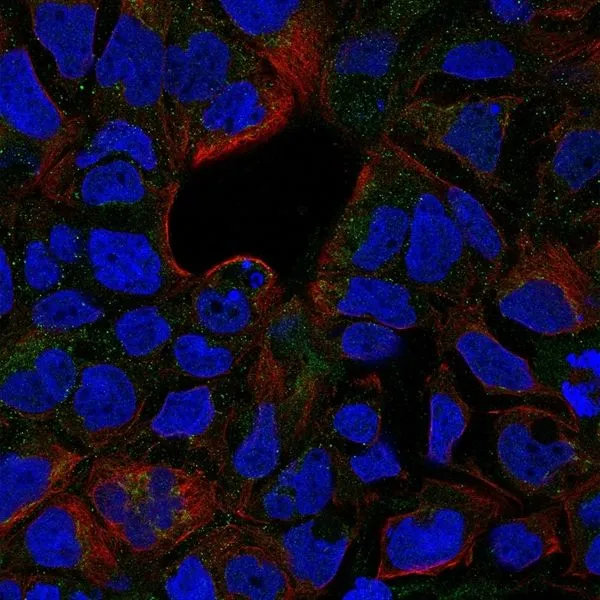TNF Receptor II antibody
GTX10502
ApplicationsImmunoFluorescence, Western Blot, ImmunoCytoChemistry
Product group Antibodies
TargetTNFRSF1B
Overview
- SupplierGeneTex
- Product NameTNF Receptor II antibody
- Delivery Days Customer9
- Application Supplier NoteWB: 1 microg/ml. ICC/IF: 5-15 microg/ml. *Optimal dilutions/concentrations should be determined by the researcher.Not tested in other applications.
- ApplicationsImmunoFluorescence, Western Blot, ImmunoCytoChemistry
- CertificationResearch Use Only
- ClonalityPolyclonal
- ConjugateUnconjugated
- Gene ID7133
- Target nameTNFRSF1B
- Target descriptionTNF receptor superfamily member 1B
- Target synonymsCD120b, TBPII, TNF-R-II, TNF-R75, TNFBR, TNFR1B, TNFR2, TNFR80, p75, p75TNFR, tumor necrosis factor receptor superfamily member 1B, TNF-R2, TNF-RII, p75 TNF receptor, p80 TNF-alpha receptor, tumor necrosis factor beta receptor, tumor necrosis factor binding protein 2, tumor necrosis factor receptor 2, tumor necrosis factor receptor type II
- HostGoat
- IsotypeIgG
- Protein IDP20333
- Protein NameTumor necrosis factor receptor superfamily member 1B
- Scientific DescriptionTNF RII (p75, CD120b) is a 75 kD transmembrane glycoprotein originally isolated from a human lung fibroblast library. Among the multitude of cells known to express TNFRII are monocytes, endothelial cells, Langerhans cells, and macrophages. Mouse to human amino acid sequence identity in the TNFRII cytoplasmic domain is 73 %, while amino acid sequence identity in the extracellular region falls to 58%. This drop in extracellular identity is reflected in the observation that human TNF-alpha is not active in the mouse system. TNF RII to TNF RI, amino acid sequence identity is only about 20% in the extracellular region and 5% in the cytoplasmic domain. TNF RII consists of a 240 amino acid residue extracellular region, a 27 amino acid residue transmembrane segment and a 173 amino acid residue cytoplasmic domain. TNF R1 and TNF R2 are members of a family of structurally related membrane receptors that includes lymphotoxin receptor, Fas, WSL1, DR4, CD40, CD30, CD27, 41BB, OX40, and p75 nerve growth factor receptor. Members of the TNFR family can interact through their cytoplasmic domains with a range of intracellular signalling proteins, most of which fall into two distinct groups. The first is the death domain containing proteins, including TRADD, FADD/MORT1, and RIP, which associate directly with receptors also containing death domains, such as TNF R1 and Fas. The second is the TRAF proteins. TRAF1 and TRAF2 were originally identified by their association with the cytoplasmic domain of TNFR2. TRAF proteins appear to function as adaptor proteins. TRAF2 directly binds at least eight intracellular molecules, including TRAF1, c-IAP1, c-IAP2, I-TRAF/TANK, A20, TRIP, RIP, and NIK (Hsu et al). The best characterized TRAFmediated signal transduction pathway is the activation of NF-B transcription factors. TRAF2 mediates NF-B activation via the recruitment of the serine/threonine kinase NIK, which can in turn activate CHUK, an IBspecific kinase that triggers IB degradation. In addition to recruiting mediators of NF-B activation, TRAF2 can bind at least three other molecules (I-TRAF/TANK, A20, TRIP) that inhibit its ability to activate NF-B.
- Storage Instruction-20°C or -80°C,2°C to 8°C
- UNSPSC12352203




![ELISA analysis of recombinant human Soluble TNF Receptor II protein using GTX54417 TNF Receptor II antibody [MR2-1]. as capture antibody used in different concentrations.](https://www.genetex.com/upload/website/prouct_img/normal/GTX54417/GTX54417_20201207_ELISA_1_w_23060900_710.webp)